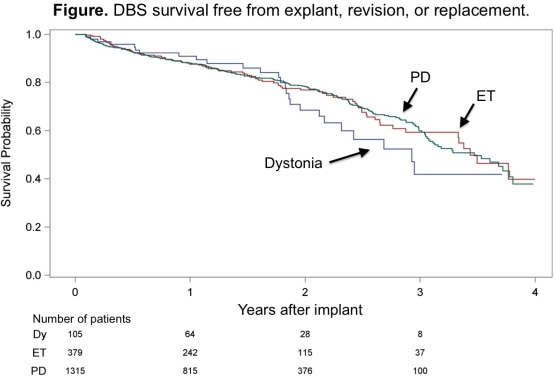Session Information
Date: Monday, June 20, 2016
Session Title: Surgical therapy: Parkinson's disease
Session Time: 12:30pm-2:00pm
Location: Exhibit Hall located in Hall B, Level 2
Objective: Determine need for programming for contemporary DBS systems, and the rate of explant, revision, or replacement.
Background: DBS provides relief for motor symptoms of Parkinson’s disease (PD), Essential Tremor (ET) and dystonia. Constant-voltage systems traditionally used for DBS may require programming changes in the years after implant. Usage as well as any time-dependent variations in coupling efficiency may also have an impact on realized device longevity.
Methods: This analysis used the Truven Health MarketScan dataset of all medical claims for patients covered by private or Medicare supplemental insurance. Patients were included if there was a DBS implant from April 2009-March 2012 and at least 1 year of prior enrollment without DBS. Exclusion criteria were a primary diagnosis other than PD, ET or dystonia, or a lead for any type of neuromodulation other than DBS. Patients were evaluated for pulse generator analysis and additional programming each year after implant. Kaplan-Meier analysis was used to determine freedom from explant, revision, or replacement.
Results: There were 1799 patients with de novo DBS implants (age 62±13 years, 66% male, 44% Medicare), of whom 1315 had PD (73%), 379 had ET (21%), and 105 had dystonia (6%). Longevity for DBS systems at 3 years (see Figure) was 42% for dystonia, 59% for ET, and 60% for PD (log-rank P = 0.88). In the 1187 patients with a full year of follow-up including visits for DBS, the year after implant averaged 4.6±3.8 programming visits and 0.7±1.0 additional visits for analysis without programming. The largest number of programming visits for any patient was 35. For 527 patients with 2 years of follow-up, there were 2.4±2.5 (maximum 19) programming sessions in the second year after implant. For patients with over 2 years of follow-up, there were an additional 2.2±2.3 (maximum 17) programming visits more than 2 years after implant. Nearly 76% (988 of 1308) of all DBS follow-up visits beyond 2 years after implant included a billing code for programming the DBS system. 
Conclusions: The predominantly constant-voltage DBS systems implanted over this time period require several programming visits each year in the years after implant. Future studies should determine if real-world programming requirements differ for constant-current vs. constant-voltage DBS, and whether programming frequency has an effect on longevity.
To cite this abstract in AMA style:
M. Tagliati, E. Karst. DBS programming requirements and longevity [abstract]. Mov Disord. 2016; 31 (suppl 2). https://www.mdsabstracts.org/abstract/dbs-programming-requirements-and-longevity/. Accessed December 19, 2025.« Back to 2016 International Congress
MDS Abstracts - https://www.mdsabstracts.org/abstract/dbs-programming-requirements-and-longevity/
